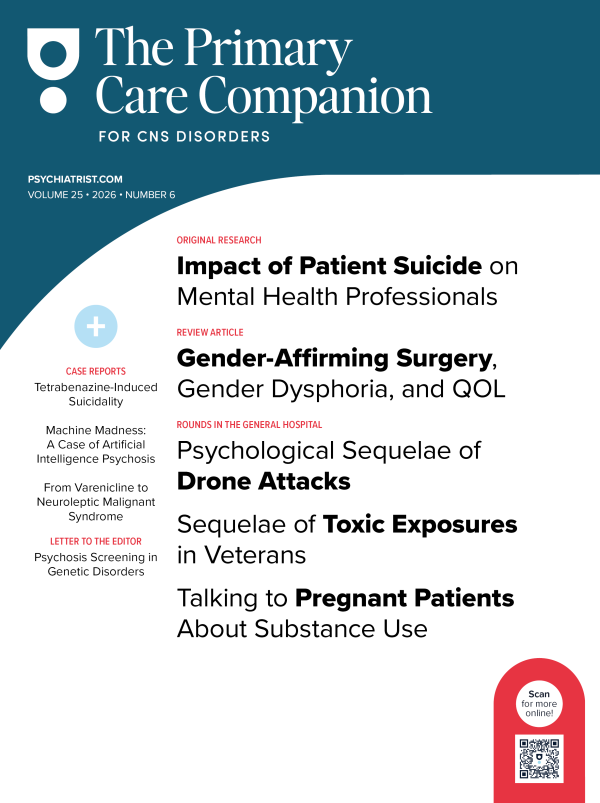Because this piece does not have an abstract, we have provided for your benefit the first 3 sentences of the full text.
To the Editor: Venlafaxine is a serotonin-norepinephrine reuptake inhibitor (SNRI) that is commonly used to treat multiple disorders including generalized anxiety disorder (GAD). We present a case of serotonin sensitivity and withdrawal with low-dose venlafaxine.
Case report. Mr A is a 24-year-old, single, white man with GAD who was started on venlafaxine extended-release (XR) 37.5 mg once daily by his primary care provider.
Serotonin Sensitivity and Withdrawal With Low-Dose Venlafaxine
To the Editor: Venlafaxine is a serotonin-norepinephrine reuptake inhibitor (SNRI) that is commonly used to treat multiple disorders including generalized anxiety disorder (GAD).1 We present a case of serotonin sensitivity and withdrawal with low-dose venlafaxine.
Case report. Mr A is a 24-year-old, single, white man with GAD who was started on venlafaxine extended-release (XR) 37.5 mg once daily by his primary care provider. He was taking no other prescriptions, over-the-counter medications, or illicit drugs. Mr A reported having neck spasms and mild tremors in his hands after starting this dose, but the side effects resolved on their own after the first 2 days. After 2 months, the dose was increased to 75 mg once daily by his primary care provider to further address his GAD symptoms. Within an hour after taking the first dose, he had onset of confusion (described as "brain fog"), tremors, increased perspiration, and involuntary neck spasms. Symptoms persisted for 2 weeks before he presented to the emergency department (ED). His vital signs and blood work were within normal limits.
After the ED visit, Mr A abruptly stopped taking venlafaxine on his own. A day after discontinuation, he experienced onset of asthenia, confusion, and memory loss. He presented to the ED 7 days after discontinuation, and workup was again normal. These symptoms persisted for an additional 2 months, and he remained off from work given his functional impairment. He was seen by the neurology department, and serotonin withdrawal was deemed unlikely given the low dosage of venlafaxine, the extended duration of symptoms, and the duration beyond the expected timeline for serotonin withdrawal. To rule out another etiology, a significant neurology workup was conducted including head imaging, infectious workup, autoimmune workup, electroencephalography, video encephalography, and lumbar puncture. All results were nonsignificant. Mr A was diagnosed with illness anxiety disorder (DSM-5 criteria) and referred to the psychiatry department.
Given the onset of his symptoms in the context of venlafaxine initiation and withdrawal, serotonin was reintroduced to his system. He was started on fluoxetine 5 mg daily. After 2 weeks, he reported a 35% improvement in symptoms. After another 2 weeks, he reported no further improvement. Venlafaxine immediate-release (IR) 9.375 mg twice daily was added to fluoxetine 5 mg. After a week, he reported a 65% improvement in confusion. After another 2 weeks, venlafaxine IR was increased to 9.375 mg in the morning and 18.75 mg at bedtime. Two weeks later, he reported an 85% improvement in confusion. A week later, he was able to return to his normal functioning including work, driving, and socializing. Before further titrations, to rule out the possibility that Mr A was a slow metabolizer, his blood venlafaxine levels were drawn (venlafaxine-S: 18 ng/mL and O-desmethyl-venlafaxine level: < 30 ng/mL). While continuing fluoxetine 5 mg, venlafaxine XR was slowly titrated up to 75 mg, and his GAD symptoms adequately remitted.
This case describes a unique presentation of serotonin sensitivity, withdrawal, and prolonged duration of associated symptoms in a young patient taking low-dose venlafaxine. Venlafaxine has been identified as one of the most common culprits of serotonin withdrawal.2 Serotonin withdrawal typically presents with asthenia, dizziness, headache, insomnia, confusion, and nervousness and has been reported in 0.1%-1% of patients with abrupt discontinuation.3,4 Onset of discontinuation symptoms typically occurs within a few days of abruptly stopping antidepressants.5 Re-exposure of the same medication or a serotonergic medication with a longer half-life, like fluoxetine, can be a helpful strategy for patients undergoing serotonin withdrawal.6
This case provides evidence for clinicians to monitor for serotonin sensitivity and withdrawal in patients taking low-dose venlafaxine, particularly those who are naive to selective serotonin reuptake inhibitors and SNRIs. The venlafaxine dosage should be tapered gradually and the patient monitored. The period required for tapering may depend not only on the dose or duration of therapy but also on the individual patient.3,4
References
1. Rickels K, Etemad B, Khalid-Khan S, et al. Time to relapse after 6 and 12 months’ treatment of generalized anxiety disorder with venlafaxine extended release. Arch Gen Psychiatry. 2010;67(12):1274-1281. PubMed CrossRef
2. Taylor D, Stewart S, Connolly A. Antidepressant withdrawal symptoms-telephone calls to a national medication helpline. J Affect Disord. 2006;95(1-3):129-133. PubMed CrossRef
3. Effexor XR (venlafaxine extended-release capsules) [package insert]. Philadelphia, PA: Wyeth Pharmaceuticals, Inc; 2017.
4. Effexor (venlafaxine) [package insert]. Philadelphia, PA: Wyeth Pharmaceuticals, Inc; 2017.
5. Warner CH, Bobo W, Warner C, et al. Antidepressant discontinuation syndrome. Am Fam Physician. 2006;74(3):449-456. PubMed
6. American Psychiatric Association. Practice Guideline for the Treatment of Patients With Major Depressive Disorder. 3rd ed. Arlington, VA: American Psychiatric Association; 2010.
aDepartment of Psychiatry, Henry Ford Health System, Detroit, Michigan
Potential conflicts of interest: Dr Bacon has served as a speaker for Janssen. Drs Kahn and Sivananthan report no financial conflicts of interest related to the subject of this article.
Funding/support: None.
Patient consent: Verbal consent was received from the patient to publish this report, and all information has been de-identified.
Published online: February 28, 2019.
Prim Care Companion CNS Disord 2019;21(1):18l02334
To cite: Khan S, Sivananthan M, Bacon O. Serotonin sensitivity and withdrawal on low-dose venlafaxine. Prim Care Companion CNS Disord. 2019;21(1):18l02334.
To share: https://doi.org/10.4088/PCC.18l02334
© Copyright 2019 Physicians Postgraduate Press, Inc.
Please sign in or purchase this PDF for $40.00.





